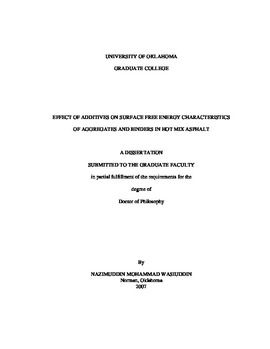| dc.contributor.advisor | Zaman, Musharraf M., | en_US |
| dc.contributor.author | Wasiuddin, Nazimuddin Mohammad. | en_US |
| dc.date.accessioned | 2013-08-16T12:20:54Z | |
| dc.date.available | 2013-08-16T12:20:54Z | |
| dc.date.issued | 2007 | en_US |
| dc.identifier.uri | https://hdl.handle.net/11244/1261 | |
| dc.description.abstract | U.S. spends approximately $20 billion/year on asphalt pavements with disproportionately high maintenance costs of $9.3 billion/year. Better performance of asphalt pavements is crucial to reducing these maintenance costs. During the past two decades significant advances have been made in understanding the behavior of hot mix asphalt (HMA) and in improving the design of asphalt pavements. In spite of these efforts, moisture-induced damage (also called stripping) is still one of the most common (75% of total road damage in one of the states surveyed) and complex problems. In this study, a mechanism-based approach based on the surface free energy (SFE) characteristics of asphalt binders and aggregates was used to elucidate on the asphalt-aggregate interactions for moisture-induced damage mechanisms. Researchers at the Texas Transportation Institute (TTI) have been using the SFE method to evaluate different asphalt binders and aggregates for moisture-induced damages. In this study, asphalt binders and aggregates were evaluated for moisture-induced damage after being modified with four different types of additives, namely liquid amines, styrene-butadiene rubber (SBR) emulsion, commercial wax and synthetic zeolite. Based on their effects relative to control samples without additives, the moisture-induced damage mechanisms are explained. A chemical model was developed which can explain that basic chemical compounds such as amines in the form of anti-strip additives reduce the acid component of SFE and increase the base component of SFE of an asphalt binder and favor the adhesion between acidic asphalt binders and acidic aggregates. The model can be used to explain that the beneficial effect of anti-strip additives in acid-base characteristics of asphalt binders is severely reduced by Rolling Thin Film Oven (RTFO) aging and Pressure Aging Vessel (PAV) aging. The analyses also provides an explanation that the acid SFE of acidic aggregate such as sandstone is significantly reduced and the base SFE is increased by SBR coating and thus, favors the adhesion between an acidic asphalt binder and an acidic aggregate. Besides the acid-base characteristics, the model can explain wettability (spreading coefficient), adhesion (free energy of adhesion) and moisture susceptibility (spontaneous change in free energy under water). One warm mix asphalt (WMA) additive, SasobitRTM (a commercial wax) was found to increase the wettability and decrease the adhesion of asphalt binders significantly. No significant effect of the second WMA additive, Aspha-MinRTM (a synthetic zeolite) was observed. Therefore, the chemical model proposed in this study has a set of parameters, namely Lewis acid surface parameter, Lewis base surface parameter, wettability, adhesion and moisture susceptibility that were found to be important in explaining the asphalt-aggregate interaction mechanisms. In this dissertation, the effects of amine anti-strip, RTFO and PAV-aging, and SBR polymer coating are presented in Chapters 2, 3 and 4, respectively. Effects of Sasobit RTM and Aspha-MinRTM on the binder rheology and the SFE characteristics are presented in Chapters 5 and 6, respectively. The results of this study can be used as a tool for cataloging of materials to predict moisture-induced damage in asphalt pavement. | en_US |
| dc.format.extent | xiii, 151 leaves : | en_US |
| dc.subject | Pavements, Asphalt Oklahoma. | en_US |
| dc.subject | Binders (Materials) | en_US |
| dc.subject | Engineering, Civil. | en_US |
| dc.subject | Asphalt concrete Moisture. | en_US |
| dc.title | Effect of additives on surface free energy characteristics of aggregates and binders in hot mix asphalt. | en_US |
| dc.type | Thesis | en_US |
| dc.thesis.degree | Ph.D. | en_US |
| dc.thesis.degreeDiscipline | School of Civil Engineering and Environmental Science | en_US |
| dc.note | Adviser: Musharraf M. Zaman. | en_US |
| dc.note | Source: Dissertation Abstracts International, Volume: 68-10, Section: B, page: 6832. | en_US |
| ou.identifier | (UMI)AAI3283862 | en_US |
| ou.group | College of Engineering::School of Civil Engineering and Environmental Science | |
